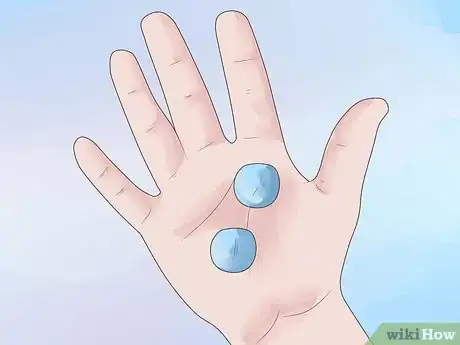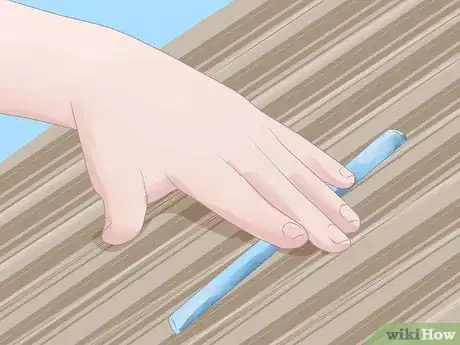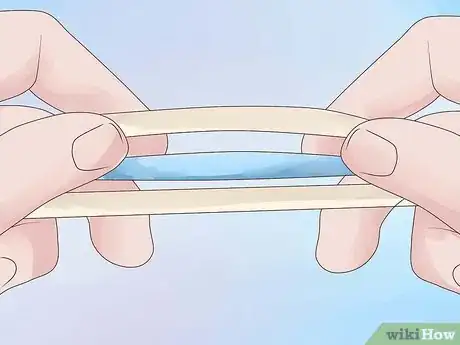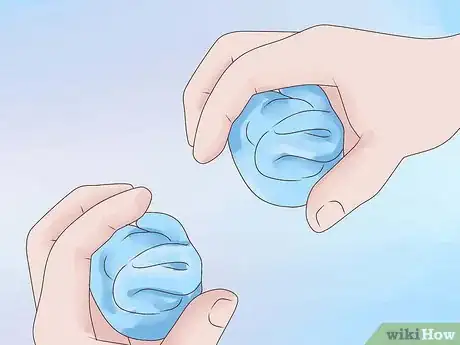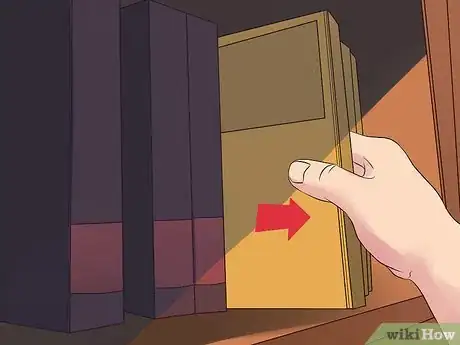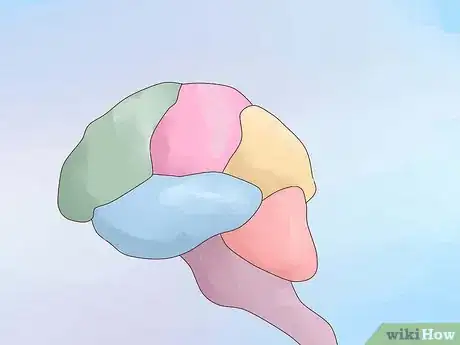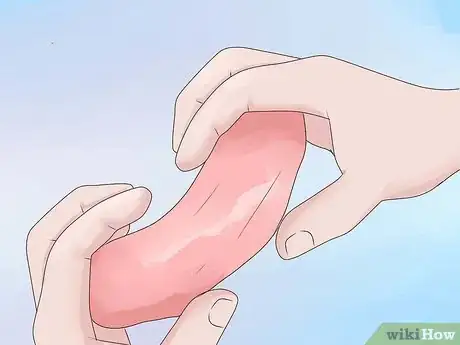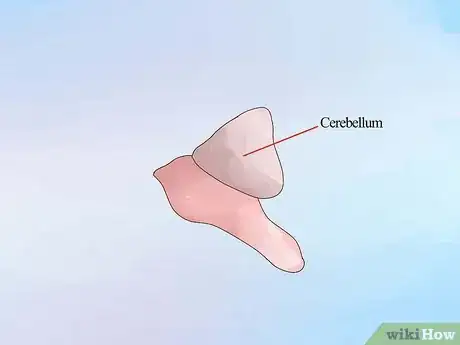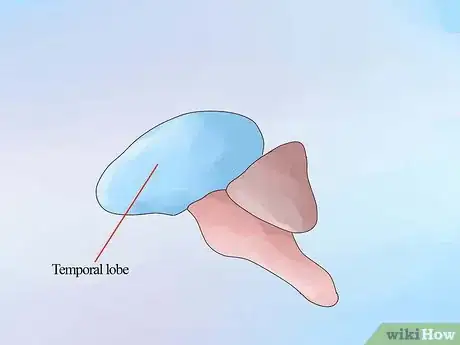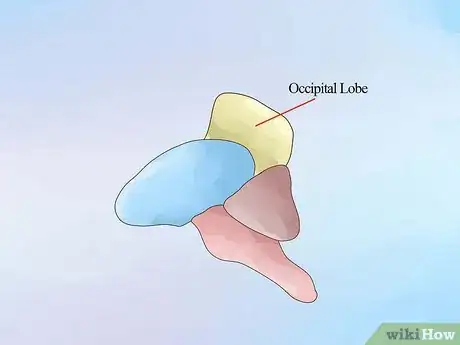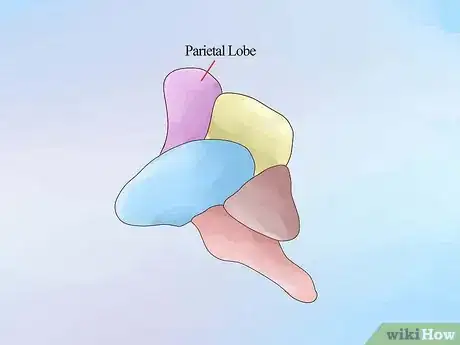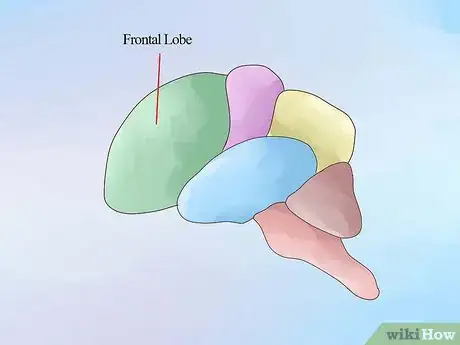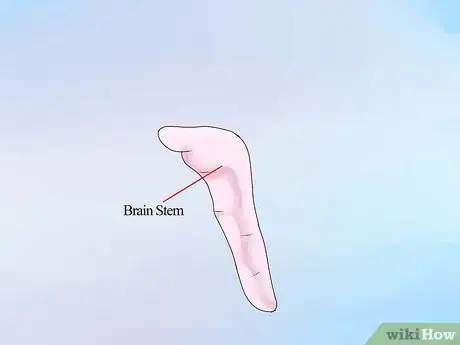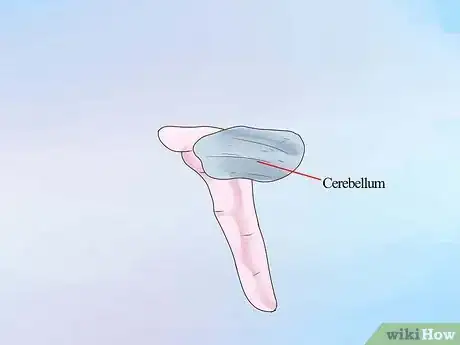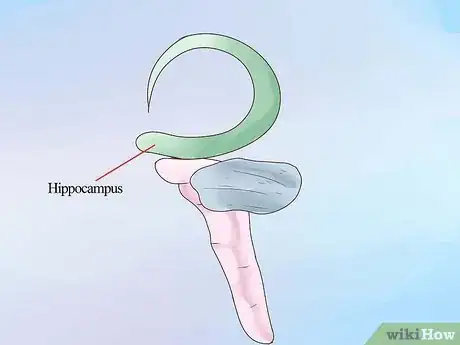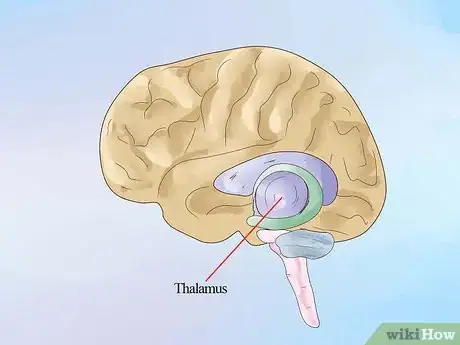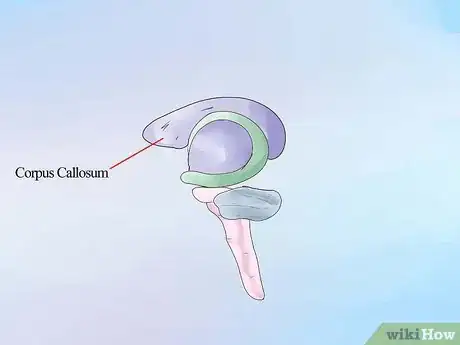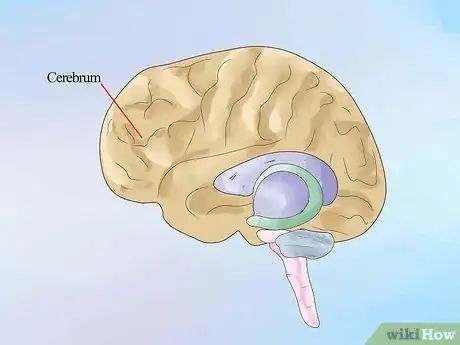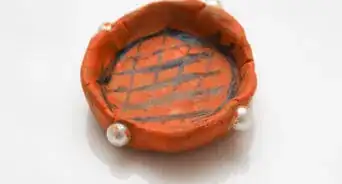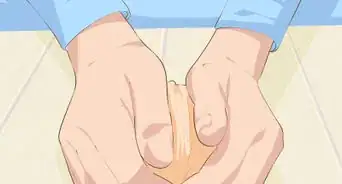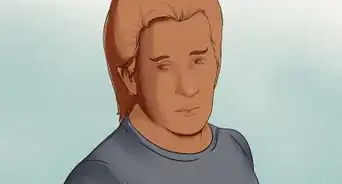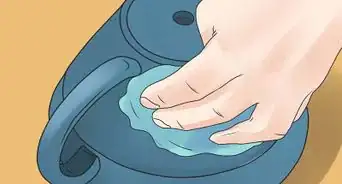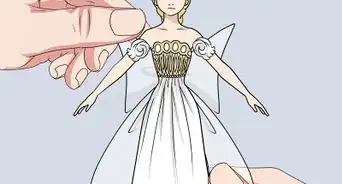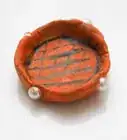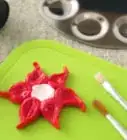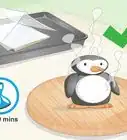This article was co-authored by wikiHow Staff. Our trained team of editors and researchers validate articles for accuracy and comprehensiveness. wikiHow's Content Management Team carefully monitors the work from our editorial staff to ensure that each article is backed by trusted research and meets our high quality standards.
There are 11 references cited in this article, which can be found at the bottom of the page.
This article has been viewed 141,887 times.
Learn more...
The brain is a complex organ, but with a little guidance, you can create a rough model of it out of clay. Making the basic brain shape is very simple. For a more accurate and scientific project, though, try making an advanced or more detailed brain model.
Steps
Crafting a Simple Brain
-
1Pinch off two balls of modeling clay. For a brain with a diameter of 4 inches (10cm), each ball of clay you pinch off should be about 2 inches (5cm) in diameter. This brain will only be one color. Choose a pale pink or gray clay for best results.
- Each ball of clay you pinch off during this step will need to be about half the desired size of your final brain. When in doubt, pinch off a little more rather than pinching off a little less. It will be easier to remove clay later than it will be to add clay.
-
2Roll each ball into a long rope. Place one ball of clay between your palms. Rub your hands back and forth over the clay. This process should cause the clay to gradually roll out into the form of a rope. Once the rope begins to exceed the width of your palm, place the clay on a table or other flat surface. Place both palms on the clay and continue rolling the clay to expand the length. Keep going until you have a rope that is about 4 inches (10 cm) long and 1/8 inch (31mm) wide. Repeat with the other ball.
- Do your best to use equal pressure on every portion of your clay rope to maintain uniform width for the length of rope.
- If one area is thicker than the other, apply more pressure in this area to thin it out.
- You can alter the thickness and length depending on how large or small you want the brain to be. The length of each rope will need to be about the same measurement as your desired final diameter. Add or subtract 1/16 inch (16mm) in width for every 2 inches (5cm) you add or subtract in length.
Advertisement -
3Fold each rope into a brain hemisphere. There is no precise pattern you need to follow for this. Twist, turn and fold the rope over itself to create a random pattern of the surface of the brain. This ball will be one lobe of the brain, and when done, it should be a little longer than it is wide. Repeat with the other rope.[1]
- Each hemisphere should have slightly flat side side along the length of the lobe where the two will fit together. This will flatten more when you press the two lobes to connect them.
- The bottom of the lobe should also be slightly flatter than the top and exterior sides of each lobe.
- Try not to smooth out the creases created on the surface as you make this ball. This rope-like pattern is what will give the clay a "brainy" look.
-
4Press the two lobes together. Hold one lobe in each hand and gently press them together to attach the lobes into one brain figure. Use enough pressure to make the two portions of clay hold together.
- Do not press too hard since doing so can flatten the brain out or smooth out the ropes.
- The final brain should be slightly longer than it is wide..
Building a Brain Atlas
-
1Consult a basic brain atlas. It will be much easier to build a brain atlas if you first reference a picture of one. Doing so will make it easier to gauge where each piece fits in and how that piece should be shaped.[2]
-
2Choose six different colors of clay. Each color will be used to create a different section of the brain. Using different colors will make it easier for you to separate and identify each part of the brain.
- Use a different color of clay for each section of the brain.
- No particular color is assigned to a specific section of the brain in the atlas. Uses whichever color meets your preference.
-
3Form the brain stem. Pinch of a small amount of clay and roll it between your palms to create a thick rope. This section will have a slight “s” shape or elbow. Smooth the rope with your fingers until the top of it curves upward and to the left, while the bottom should be slightly longer than the top section and sink off to the right. The bottom should also have a pointed tip, while the top should have a flat edge and look a bit wider overall.
-
4Attach the cerebellum. Pinch off roughly half the amount you used with creating the brain stem. Roll and form this into a triangle with rounded edges. Position it so that one side of the triangle sits in the upper curve of the brain stem.[3]
-
5Create the temporal lobe. Pinch off a roughly the same size lump of clay you used for the brain stem. Roll this clay into an oval shape. Place the center of this oval onto the top of the brain stem, and press it gently to attach the two pieces of clay together. The bottom, left half of the oval should reach half way up the left side of the cerebellum if we consider the bottom of the triangle to be the part matched to the brain stem.[4]
-
6Move on to the occipital lobe. Take a piece of clay roughly the same size as your temporal lobe. Roll and flatten this piece into a quadrilateral which splays out at the top making a muffin shape. Position it so that the bottom center of the lobe connects to the top, left 1/4 of the temporal lobe. The right side right side of the occipital lobe should cover the other left half of the cerebellum, with the muffin top spilling slightly over the top of the cerebellum.[5]
-
7Add the parietal lobe. Pinch off slightly more clay than the amount used to create your occipital lobe. Form another rectangle just larger than a square. One bottom shorter edge of the rectangle should cover the rest of the right half of the oval made by the temporal lobe. The rectangle should lean slightly to the right.[6]
-
8Make the frontal lobe to complete the atlas. This should be your largest bit of clay, and slightly larger than your original amount used to create the brain stem. Roll it into an oval, then slightly flatten the bottom right and left sides to attach them to the rest of your brain atlas. Wedge this final piece in place on the left of your model to create the front of the brain. The flattened bottom right section will attach to the parietal lobe, while the bottom left covers the top left half of the temporal lobe oval, slightly overlapping the edge.[7]
Forming a Detailed Brain Model
-
1Make the brain stem. Form two short ovals with your clay. One should be half the length of the other. Attach the shorter of the two to the left side of the longer, and smooth them out until they form one piece.[8]
- This smaller bulge is the "pons" of the brain stem.
- If you want to make this model part atlas, as well, you should use seven different colors, one for each part of the detailed brain model.
-
2Form the cerebellum. The cerebellum looks like a small circle with two thin ropes connecting it to the brain stem. Between your palms, roll a small circle of clay, about the same size as the thinner area of the brain stem. Roll a small rope and attach this to the bottom of your cerebellum, which will be pressed against the right side of the brain stem.
- Pinch a portion of the clay at the bottom of the cerebellum to give you something to attach the ropes to.
-
3Connect the cerebellum to the brain stem. Lay the pieces against the right side of the brain stem, along the pons and slightly covering some of the stem. Gently press the two pieces together until they stick. Connect the small rope with one side running down the shaft of the brain stem, and the other running upward over the pons.
- The cerebellum has many small lines running horizontally. These are much thinner and close together than the pattern of the rest of the outer surface. Take a knife or sharp pencil to draw these lines across the cerebellum.
-
4Create the hippocampus. Make a small slug using the clay. The length should roughly match the length of the brain stem. Press one end onto the top of the brainstem and curve the rest to create a backward “c” so the the tail nearly meets the head which is connected to the brain stem.
- The top of the brain stem should be completely covered.
- For added realism, use a pointed tool to draw vertical lines on the portion of the hippocampus connecting to the brain stem.
-
5Fit the thalamus inside the curve of the hippocampus. Pinch off a blob of clay that is just large enough to fit into the gap created by the curve of the hippocampus. Roll it into a circle and place it directly inside this gap.[9]
- This will also assist in maintaining the curve of the hippocampus in your model.
-
6Connect the corpus callosum. Roll slightly less clay than you used for the hippocampus to create the corpus callosum. Make a long rope roughly the same thickness as the "tail" of the hippocampus. Position it so that it lies directly on top of this curved portion of the hippocampus.
- The left end should touch the bottom "head" of the hippocampus. The right end should touch the cerebellum.
-
7Make the cerebrum. This is the largest portion of the brain which carries a pattern of folds. Create a dozen or so small ropes. Each one should be short and and about as thin as the rope portions of your cerebellum. You will need to attach small, curved ropes to one another and build them around the current curve of the brain.[10]
- Curve one small rope on the top of the round portion of the cerebellum, but do not allow it to extend down to the side. Fold it around, stacking it on itself, so that it touches the corpus callosum and does not extend further right than the right side of the cerebellum.
- Continue stacking, curving, and piecing the ropes together in a similar manner until you make your way around the corpus callosum and touches the left end of the hippocampus.
- Use your finger or a clay shaping tool to smooth the outside of the cerebrum. This outer edge should be an even curve.
-
8Attach the amygdala to complete the model. Pinch off a small oval roughly one-third the size of the thalamus. Roll this into an oval, then wedge this oval into the front of the brain, in between the bottom edge of the cerebrum and the upper edge of the brain stem pons.[11]
Community Q&A
-
QuestionHow would you be able to attach the brain to a poster for a school project?
 Undertale4141Top AnswererYou can make a small cardboard square coming out from the poster to put your model brain on.
Undertale4141Top AnswererYou can make a small cardboard square coming out from the poster to put your model brain on. -
QuestionHow do I harden the brain model so it does not fall apart or change shape?
 Community AnswerJust allow it to cool and dry, and it should hold its shape.
Community AnswerJust allow it to cool and dry, and it should hold its shape. -
QuestionWhat color should it be?
 Elizabeth BolsterCommunity AnswerYou can make it any color you want, but brains are generally depicted in a shade of pink.
Elizabeth BolsterCommunity AnswerYou can make it any color you want, but brains are generally depicted in a shade of pink.
Things You'll Need
Simple Brain
- Light pink or gray clay
Approximate Brain Atlas
- Clay, in six different colors (red, brown, yellow, purple, green, blue)
Detailed Brain Model
- Light pink or gray clay
- Pointed clay shaping tool, toothpick, or sharpened pencil (optional)
References
- ↑ http://brainmadesimple.com/left-and-right-hemispheres.html
- ↑ http://faculty.washington.edu/chudler/gif/clayb1.jpg
- ↑ http://www.neuroskills.com/brain-injury/cerebellum.php
- ↑ http://brainmadesimple.com/temporal-lobe.html
- ↑ http://brainmadesimple.com/occipital-lobe.html
- ↑ http://brainmadesimple.com/parietal-lobe.html
- ↑ http://brainmadesimple.com/frontal-lobe.html
- ↑ http://www.strokeeducation.info/brain/brainstem/
- ↑ http://brainmadesimple.com/thalamus.html
